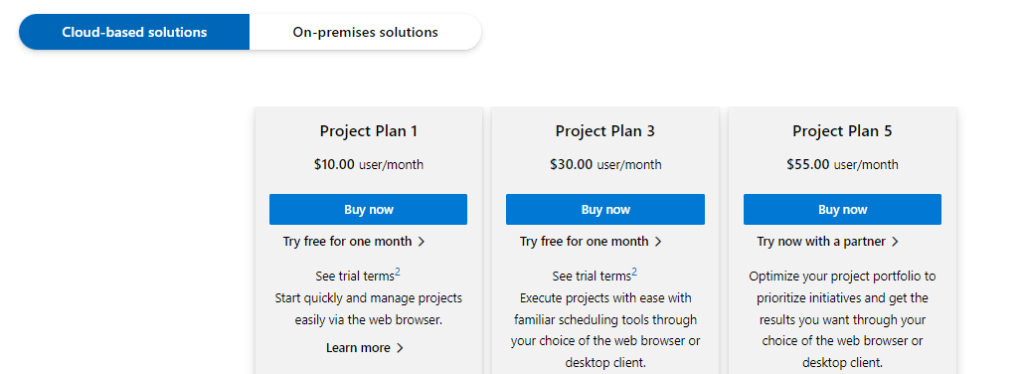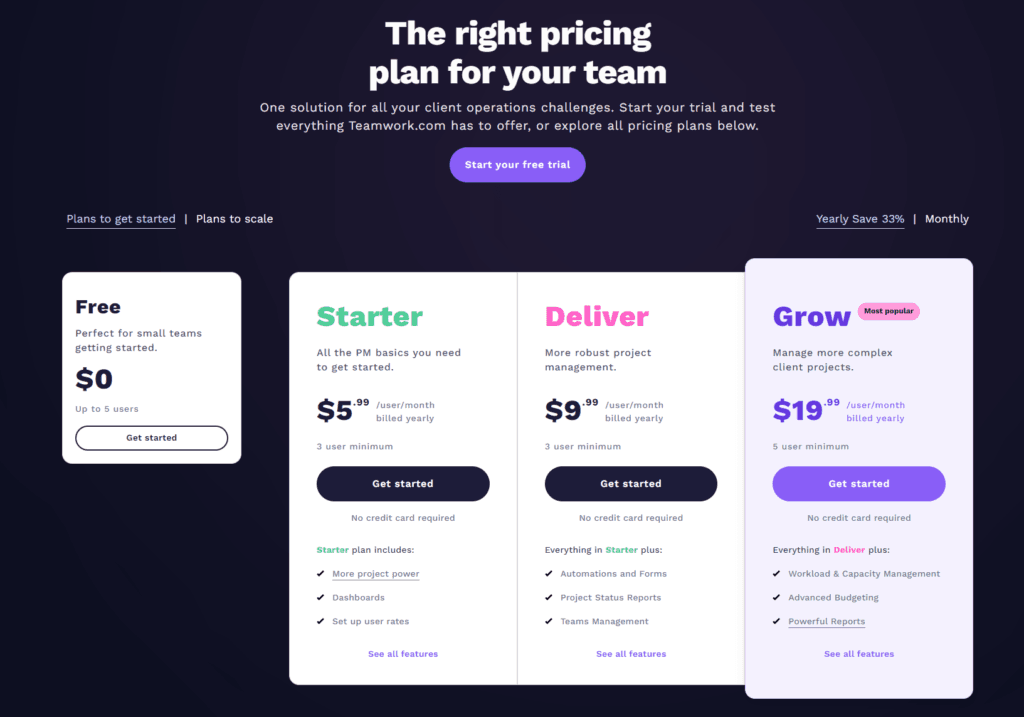In the bustling arena of project management tools, where the clash of functionality meets the clash of user experiences, two contenders stand out for their prowess and pedigree: Microsoft Project and Teamwork. On one side, Microsoft Project wields its decades of refinement, offering a depth of features born from a legacy in software excellence. On the other, Teamwork flexes its intuitive design and collaborative spirit, appealing to modern teams with its sleek interface and user-friendly approach. But which among these is the best ally for your project management odyssey?
Microsoft Project | Teamwork |
|---|---|
| G2 Score – 4 out of 5 stars | G2 Score – 4.4 out of 5 stars |
| TrustRadius Score – 7.6/10 | TrustRadius Score – 7.9/10 |
Setting Sail with Ease of Use and User Interface
The journey of a thousand tasks begins with a single click—the ease with which you navigate your project management tool can define the efficiency and mood of your project voyage. Let’s delve into how Microsoft Project and Teamwork stand up to the crucial test of usability.
Microsoft Project:
Stepping into Microsoft Project is like entering a vast library of knowledge. The tool is rich with features, each designed with the meticulous detail you’d expect from a veteran in project management. From Gantt charts that trace your project’s lineage to complex reporting tools that forecast your project’s future, Microsoft Project is built for those who speak the nuanced language of project management. However, this depth comes with a steep learning curve, reminiscent of mastering an ancient tome. Newcomers might find the interface daunting, a labyrinth of functionalities each unlocking a different aspect of project management prowess. Yet, for those willing to embark on this journey, Microsoft Project offers unparalleled control and insight, a testament to its enduring legacy in the software realm.
Teamwork:
In contrast, Teamwork greets you with the warmth of a familiar inn. Its interface, designed for the modern voyager, prioritizes intuitiveness and ease of collaboration. Navigation within Teamwork feels natural, with a layout that encourages discovery and interaction. Projects, tasks, and communications weave seamlessly together, creating a tapestry that portrays your project’s narrative in vivid detail. For teams that thrive on collaboration and seek a tool that blends comprehensive features with an approachable interface, Teamwork offers a sanctuary. It’s a platform where project management is demystified, making it accessible to novices and seasoned project managers alike.
Integration Capabilities
In the voyage of project management, the ability of your chosen tool to seamlessly integrate with other software represents the winds that propel your project forward. In today’s digital ecosystem, where tools and apps form an intricate network of workflows, seamless integration is not just a convenience—it’s a necessity.
Microsoft Project:
Microsoft Project has long been a stalwart on the seas of project management, and its integration capabilities reflect a tool that’s deeply embedded in the corporate infrastructure of many organizations. With its seamless integration into the broader Microsoft ecosystem—encompassing Office 365, Teams, and SharePoint—Microsoft Project offers a level of coherence and synergy for teams already navigating these waters. This integration extends the functionality of Microsoft Project, enabling smoother communication, document management, and collaboration across platforms that many teams use daily. However, when charting courses that require integration with tools outside the Microsoft ecosystem, the waters can become more turbulent, requiring additional navigation tools or custom solutions to bridge these gaps.
Teamwork:
Teamwork, with the agility of a swift sailboat, offers a broad horizon of integration possibilities designed for the modern digital ecosystem. From direct integrations with leading cloud storage providers like Google Drive and Dropbox to communication platforms such as Slack and Zoom, Teamwork understands the importance of keeping your team’s workflow unified and streamlined. Furthermore, Teamwork’s flexibility is showcased in its ability to integrate with a variety of third-party apps through its marketplace, and for routes not directly supported, it offers webhooks and an API for custom integrations. This makes Teamwork an adaptable vessel, capable of navigating through diverse digital landscapes and ensuring that your project management tool is fully in sync with your team’s operational tools.

Related: Check out our free SEO suite

Task Management and Workflow Automation: Navigating Through the Details
Task management is the compass by which teams orient their daily activities, ensuring that each member knows their responsibilities, deadlines, and priorities. Workflow automation, on the other hand, acts like the favorable winds that propel a ship forward, automating routine processes to increase efficiency and reduce manual effort.
Microsoft Project:
Microsoft Project is renowned for its robust task management features, offering a comprehensive suite of tools that cater to detailed planning and execution. With its hierarchical task structuring, users can break down projects into subtasks and assignments, defining dependencies and milestones with precision. This level of detail is invaluable for complex projects where understanding the interplay between tasks is crucial for timely delivery. Microsoft Project’s scheduling engine automatically adjusts timelines based on task dependencies and resource availability, a powerful feature for project managers needing to forecast project timelines and allocate resources effectively.
On the automation front, Microsoft Project allows for the creation of custom workflows to automate status updates, notifications, and approval processes. This capability, though powerful, often requires a deep understanding of the software and, in some cases, integration with SharePoint for full functionality, placing it within reach of teams with specialized knowledge or dedicated project management offices.
Teamwork:
Teamwork, with its user-friendly interface and flexible task management options, offers a different sailing experience. Task assignment and tracking are streamlined, with an intuitive drag-and-drop interface that simplifies the organization of tasks into lists, boards, or Gantt charts according to the team’s preferred working style. Teamwork emphasizes collaboration and visibility, with features like task dependencies, time tracking, and workload management designed to keep teams aligned and informed.
When it comes to workflow automation, Teamwork provides a suite of automation triggers and actions that can be configured to handle routine processes, such as changing task statuses, assigning tasks based on project rules, or sending notifications. This automation is designed to be accessible, allowing teams to set up customized workflows without requiring extensive technical knowledge.
Reporting and Analytics
The ability to monitor progress, visualize outcomes, and analyze project performance data is akin to navigating by the stars—it provides direction, ensures you’re on course, and helps anticipate what lies ahead. Both Microsoft Project and Teamwork offer robust reporting and analytics features, but they cater to these needs in distinct ways.
Microsoft Project:
Microsoft Project has long been celebrated for its deep reporting capabilities. It offers a wide range of built-in templates for generating detailed reports on everything from project overview, cost, assignments, and resource allocation to more custom, in-depth analyses that cater to specific stakeholder needs. The integration with other Microsoft tools, particularly Power BI, elevates its analytics capabilities, allowing for an even greater level of detail and customization. This integration enables users to create dynamic, interactive dashboards and reports that can provide insights not just at the project level but across portfolios. The depth offered by Microsoft Project in reporting and analytics is substantial, but it requires a certain level of expertise to fully leverage, making it more suitable for organizations with dedicated project management offices or those that prioritize data-driven decision-making.
Teamwork:
Teamwork, focusing on user-friendliness and accessibility, approaches reporting and analytics with the goal of providing clear, actionable insights that are easy to understand and share. The platform offers a variety of pre-built and customizable report templates that cover project status, milestones, time tracking, and workload, among others. Teamwork’s dashboards are particularly notable for their visual appeal and configurability, providing at-a-glance insights into project health, team performance, and resource utilization. While perhaps not as deeply detailed as Microsoft Project’s, Teamwork’s reporting and analytics tools are designed to be immediately useful to teams looking to quickly assess progress and make informed decisions without the need for extensive data manipulation or analysis.
Venturing into Cost and Scalability
In the quest for the right project management tool, understanding the investment and how the tool grows with your team is as vital as charting a course through open waters. Both Microsoft Project and Teamwork present different pricing models and scalability options, tailored to accommodate a variety of team sizes, project complexities, and budgetary constraints.
Microsoft Project:
Microsoft Project offers a tiered pricing structure, aimed at providing solutions that scale with the needs of different organizations. From basic project planning and scheduling to advanced portfolio management and analytics capabilities, each tier offers more sophisticated features designed to cater to more complex project management needs. This structured approach ensures that organizations can start with a solution that fits their current needs, with the option to upgrade as their project management sophistication grows. However, it’s important to note that the cost can rise significantly as you move up tiers, with the most advanced features necessitating a considerable investment. This makes Microsoft Project a potentially more suitable option for larger enterprises or organizations with complex, high-stakes projects that can justify the higher cost for advanced capabilities.
Teamwork:
Teamwork, on the other hand, presents a pricing model that emphasizes flexibility and accessibility. With a free tier for small teams and basic projects, Teamwork makes it easy for organizations to start managing their projects without upfront investment. As needs evolve, teams can move to higher tiers, which offer additional features such as time tracking, billing, and more extensive collaboration tools. Teamwork’s pricing model is designed to be transparent and scalable, allowing teams to select the plan that best matches their size and requirements without overcommitting resources. This scalability, combined with a user-friendly platform, makes Teamwork an attractive option for small to medium-sized businesses, startups, and teams within larger organizations looking for a cost-effective project management solution.
Pricing
Microsoft Project:

Teamwork:

Conclusion
As we conclude our exploration into choosing the right project management tool between Microsoft Project and Teamwork, it’s clear that both platforms offer distinct strengths tailored to different organizational needs and preferences. From the initial considerations around ease of use and user interface, through the crucial aspects of integration capabilities, customization, flexibility, task management, workflow automation, and diving into the vital areas of reporting, analytics, cost, and scalability, each platform shines in its own way.
Microsoft Project stands out as a powerhouse for complex project management, offering depth in task structuring, scheduling, and detailed reporting that can cater to the nuanced needs of large enterprises or sophisticated projects. Its integration within the Microsoft ecosystem provides a seamless experience for teams already embedded in these tools, while its tiered pricing structure ensures that organizations can access a level of project management capability that aligns with their complexity and scale.
On the other hand, Teamwork emerges as a highly adaptable and user-friendly platform, ideal for teams seeking a tool that not only simplifies project management but also enhances collaboration and communication across projects. With its transparent pricing model and scalable plans, Teamwork is well-suited for small to medium-sized businesses, startups, and teams within larger organizations looking for an accessible yet powerful project management solution.
Read Next:
- ConvertKit vs Automizy: The Best Email Marketing Tool for 2024
- Agorapulse vs Friends+Me: The Best Social Media Management Tool for You
- SocialBee vs Later: The Best Social Media Management Tool for You
- Sprout Social vs SmarterQueue: The Best Social Media Management Tool for You
- Agorapulse vs MavSocial: The Best Social Media Management Tool for You






















Comments are closed.